Note: This publication is currently undergoing major revisions. The current publication will be replaced with a new publication based on stakeholder requirements and scientific advances. We expect to begin sharing details on this soon. If you have input on content, format, or publication frequency at any time, please contact us at cbrfc.webmasters@noaa.gov.Green Water Supply Outlook, June 1, 2010Green Water Supply Outlook, June 1, 2010
Contents
Green Summary

*Median of forecasts within each basin.
Upper Green Basin Conditions
The following conditions influenced this month's forecasts:
Precipitation:
Seasonal October through May
precipitation was 90 percent of average
in the Upper Green basin. May
precipitation was 120 percent of average.
Snow:
On June 1st, the basinwide snowpack was 95 percent of average. However, the upper part of the basin, above 10,000 feet in elevation, is not gaged. The water year snowpack peaked on April
15th at much below the average peak.
--- Upper Green basin
snow
water equivalent plot.
Streamflow:
May streamflow was near 20 percent of average.
Soil Moisture:
Modeled
soil
moisture states ranged from below average to near average heading into the winter.
Climate Forecasts:
Climate forecasts were not a factor because there is not a strong correlation
between El Nino conditions and winter precipitation in the Upper Green basin.
Forecast Summary:
Due primarily to the much below average water year peak snowpack, the April through July streamflow volume forecasts are much below average. These
forecasts
range between 47 and 73 percent of average, with a median value of 55 percent. The June through July streamflow volume forecasts range between 54 and 82 percent of average, with
a median value of 60 percent.
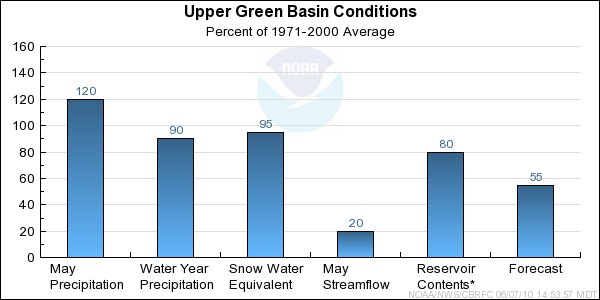
* Percent usable capacity, not percent average contents.
Click for multi-month Graph.
Yampa/White Basin Conditions
The following conditions influenced this month's forecasts:
Precipitation:
Seasonal October through May
precipitation was 95 percent of average
in the Yampa/White basin. May
precipitation was 110 percent of average.
Snow:
June 1st snow water equivalent was 80 percent of average in the basin as a whole. The seasonal snowpack peaked on April 10th at 80 percent of the average peak. This year cooler
temperatures retained some of the snowpack later into the season.
--- Yampa basin
snow
water equivalent plot.
Streamflow:
May streamflow was near 85 percent of average.
Soil Moisture:
Modeled
soil
moisture states were near average heading into the winter for the Little Snake
and White River basins. Modeled states ranged from below average to near average
heading into winter for the Yampa basin.
Climate Forecasts:
Climate forecasts were not a factor because there is not a strong correlation
between El Nino conditions and winter precipitation in the Yampa/White basin.
Forecast Summary:
Due to the near average precipitation to date, and because some of the snowpack was retained later into the season because of cooler temperatures, the April through July streamflow volume forecasts are near average at this time. These
forecasts range
between 54 and 128 percent of average, with a median value of 105 percent. The June through July streamflow volume forecasts range between 51 and 115 percent of average, with
a median value of 80 percent.
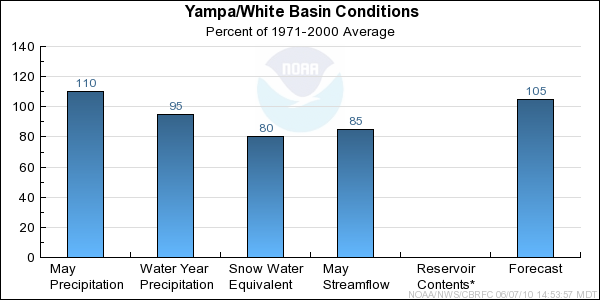
* Percent usable capacity, not percent average contents.
Click for multi-month Graph.
Duchesne Basin Conditions
The following conditions influenced this month's forecasts:
Precipitation:
Seasonal October through May
precipitation was 80 percent of average
in the Duchesne basin. May
precipitation was 90 percent of average.
Snow:
June 1st snow water equivalent was 85 percent of average in the basin as a whole.
--- Duchesne basin
snow
water equivalent plot.
Streamflow:
May streamflow was near 40 percent of average.
Soil Moisture:
Modeled
soil
moisture states were much below average to below average heading into the winter.
Climate Forecasts:
Climate forecasts were not a factor because there is not a strong correlation
between El Nino conditions and winter precipitation in the Duchesne basin.
Forecast Summary:
Due to below average water year precipitation, below average seasonal snowpack, and much below average soil moisture heading into winter, the April through July streamflow
volume forecasts continue to be much below average. These
forecasts range between 34 and 76 percent of average,
with a median value of 55 percent. The June through July streamflow volume forecasts range between 25 and 73 percent of average, with
a median value of 65 percent.
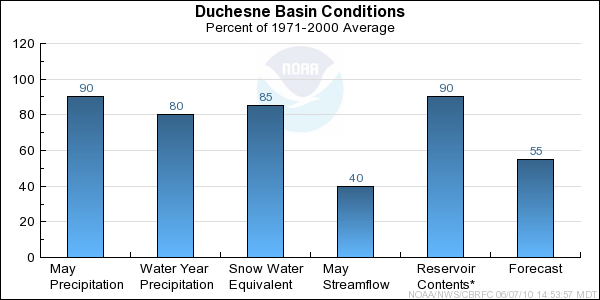
* Percent usable capacity, not percent average contents.
Click for multi-month Graph.
Lower Green Basin Conditions
The following conditions influenced this month's forecasts:
Precipitation:
Seasonal October through May
precipitation was 95 percent of average
in the headwaters of the Lower Green basin. May
precipitation was 90 percent of average.
Snow:
June 1st snow water equivalent was 50 percent of average in the Price and San Rafael basin. Elsewhere within the Lower Green the snow was essentially depleted.
--- Price basin
snow
water equivalent plot.
Streamflow:
May streamflow was near 50 percent of average.
Soil Moisture:
Modeled
soil
moisture states were much below average heading into the winter.
Climate Forecasts:
Climate forecasts were not a factor because there is not a strong correlation
between El Nino conditions and winter precipitation in the Lower Green basin.
Forecast Summary:
Due to the below average seasonal snowpack, and the much below average soil moisture heading into winter,
the April through July streamflow volume forecasts continue to be much below average. These
forecasts
range between 32 and 61 percent of average, with a median value of 45 percent. The June through July streamflow volume forecasts range between 45 and 65 percent of average, with
a median value of 50 percent.

* Percent usable capacity, not percent average contents.
Click for multi-month Graph.
Differences between the full period forecasts and the residual forecasts may not exactly equal the actual observed volumes due to rounding conventions (see Definitions section).
Reservoir Monthly Inflow Forecasts
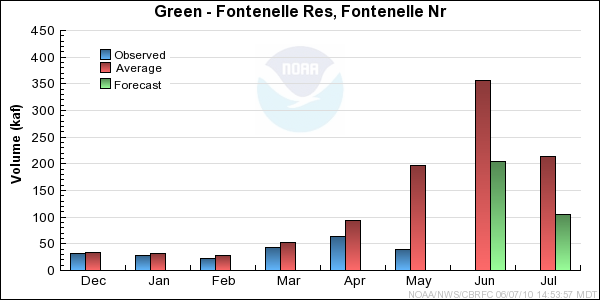

Monthly Streamflows

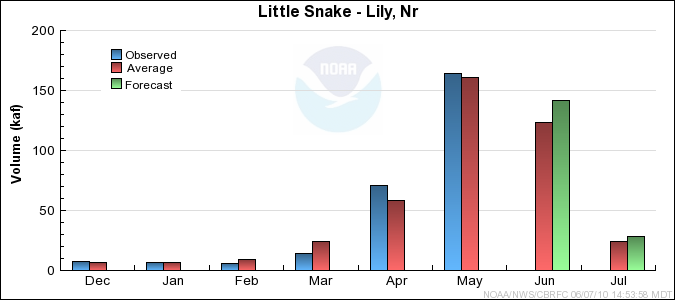
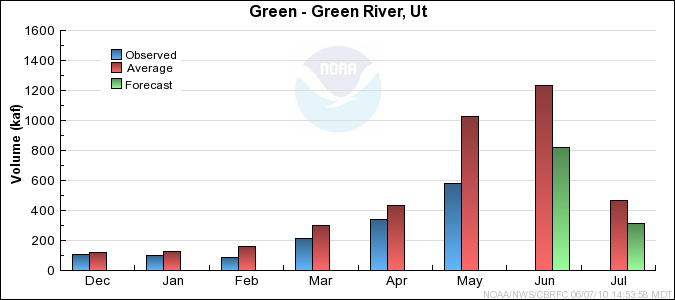
Precipitation Maps
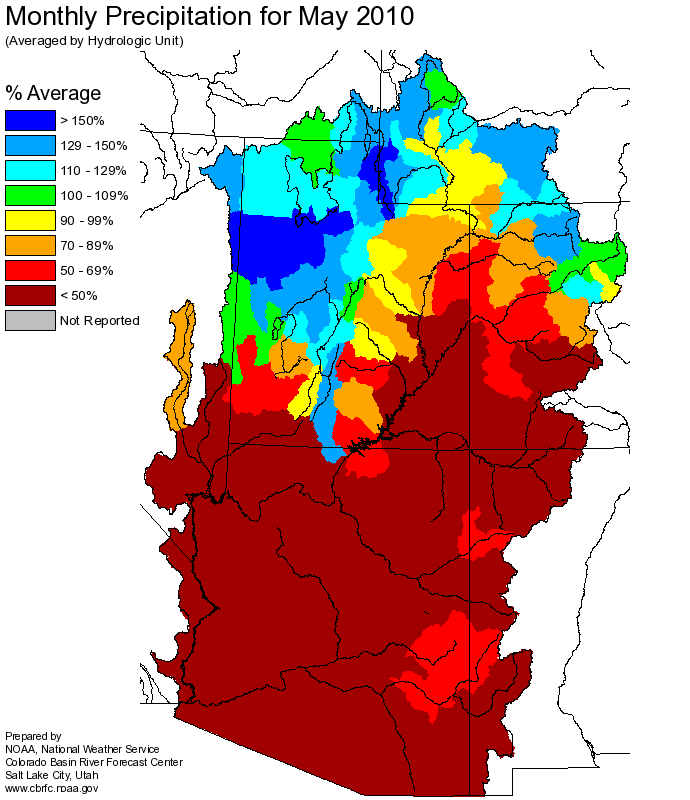
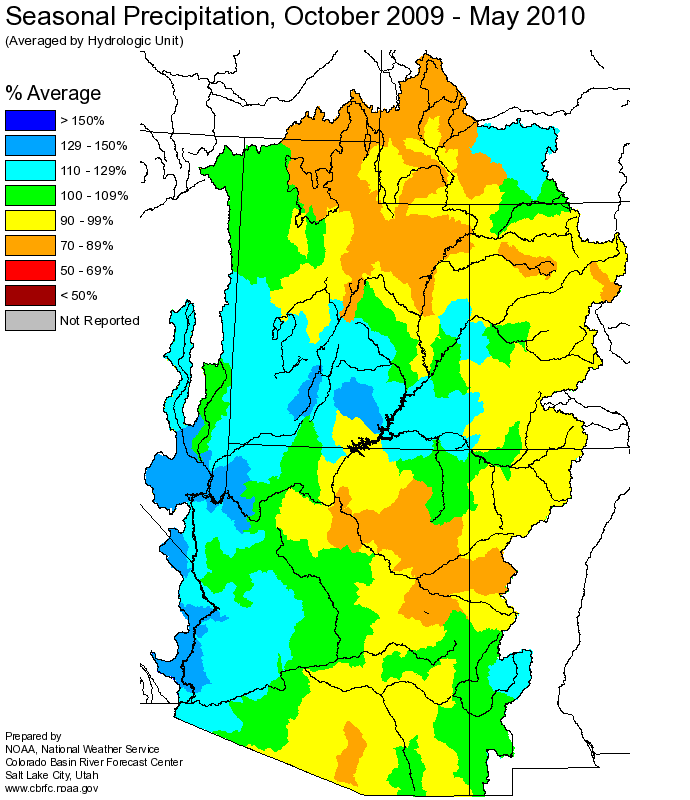
Hydrologist: William Reed













